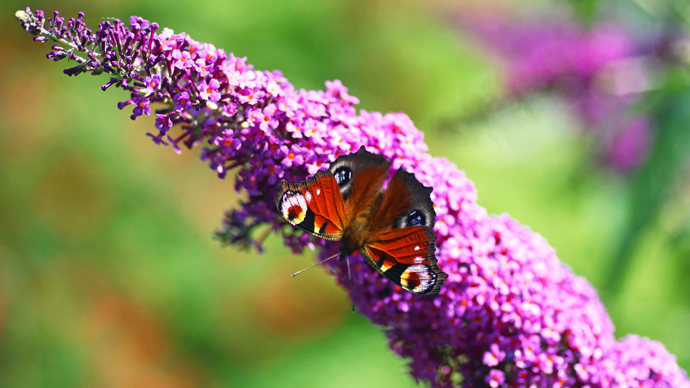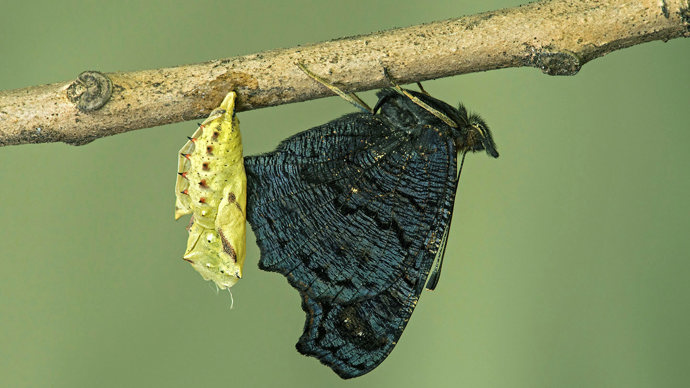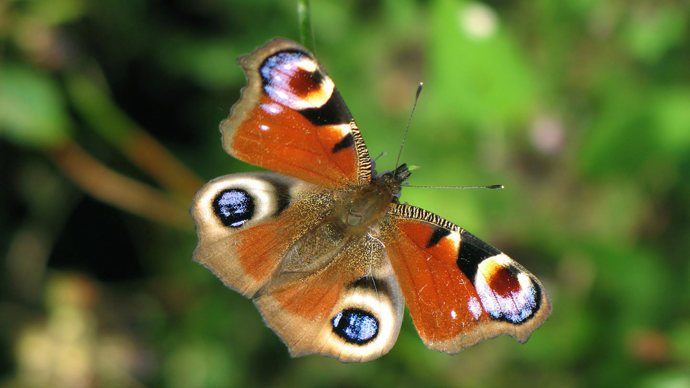Common name: peacock
Scientific name: Aglais io
Family: Nymphalids
Habitat: gardens, woodland, parks and coastal areas
Caterpillar foodplants: leaves of hop and stinging nettles
Predators: birds, rodents
Origin: native
Big. Bold. Beautiful. This stunning showstopper is instantly recognisable, with its captivating azure ‘eyes’ and orange-brown wings. Widespread and common throughout the UK, it is one of our most-loved butterflies.
Common name: peacock
Scientific name: Aglais io
Family: Nymphalids
Habitat: gardens, woodland, parks and coastal areas
Caterpillar foodplants: leaves of hop and stinging nettles
Predators: birds, rodents
Origin: native
Adults: large and unmistakable, the peacock butterfly is orange-red in colour with mesmerising azure ‘eyes’ on its wings, which help to ward off predators. The undersides of its wings are dull and almost black, resembling dead leaves. Females are larger than males.
Wingspan: 6-7cm
Caterpillars: jet black, velvety and covered in tiny white spots and short shiny black spines.

Credit: John Keates / Alamy Stock Photo
Adults: feed on nectar from flowers including thistle, betony, bluebell, cuckooflower, dandelion and teasel. Buddleia is a particular favourite for peacock butterflies.
Caterpillars: eat the leaves of stinging nettles and hop.
They usually mate in early spring, laying up to 500 eggs in May, typically on nettle leaves – the preferred food of this species’ larvae. After a couple of weeks the caterpillars hatch and spin a communal silk web, feasting on the nettles together before gradually venturing out into the open. They pupate in July, emerging as adults between July and August.

Credit: GFC Collection / Alamy Stock Photo
Adults hibernate over winter, usually in dark spaces like inside sheds and holes in trees. They fold their wings up and sleep; their dull wings allow them to blend in and rest undisturbed. Peacock butterflies then wake from hibernation during the spring, sometimes as early as March.
Peacock butterflies can live for up to 11 months.
Peacock butterflies live in woods, gardens, parks and coastal areas. They are widespread throughout the UK.

Credit: Jane Corey / WTML
As this species is widespread and very common, it’s highly likely you’ll spot it feeding on flowers on sunny days. Gardens, parks and woods are all good places to spot the peacock butterfly, particularly those with buddleia growing in them. The best time to see caterpillars is from May to July - keep an eye out for them on stinging nettles.
The peacock butterfly is abundant and not currently threatened in the UK.
When threatened, the peacock butterfly makes a hissing sound which it creates by rubbing the veins on its forewings and hindwings together.